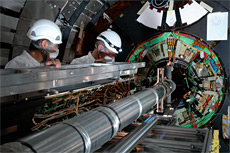Forward pixel detector ready for proton-proton collisions

FPIX team members carefully install the delicate sub-detector in
CMS. (Image courtesy of Maxwell Chertok and David Pellett)
On Wednesday, Sept. 10, members of the CMS collaboration held their
breath as the very first beam of protons circulated around the LHC at CERN.
Leading up to the big day, scientists worked around the clock to install
one of the last—and one of the most delicate—components
of the CMS experiment—the forward pixel detector.
The U.S. led the effort to build the FPIX, a roughly $10 million sub-detector
that allows physicists to precisely reconstruct particle trajectories from
collisions. The team had a detailed installation plan and didn’t
take any risks. One security measure—hire a round-the-clock security
guard and his trusty German shepherd named Wolf.
“Due to scheduling, we knew that the FPIX wouldn’t be
installed right away when it arrived at the detector hall,” said Maxwell Chertok,
a physicist at UC Davis who coordinated the installation effort.
“It was safe on the truck, but we were worried someone might steal the
vehicle. We really didn’t want our FPIX going on a joy ride through the
French countryside.” Thanks to the security team and Wolf, the FPIX was
safe.
The FPIX consists of four half cylinders, two for each end
of the detector. Each half cylinder contains two interweaving half disks of
pixel sensors that surround the beam pipe. Installing these fragile disks would
raise anyone’s blood pressure. “If the pieces touch,
they break,” Chertok said. “If you touch the beam pipe, it
breaks.”
John Conway, a physicist at UC Davis, led the U.S. team that designed and
built the FPIX installation equipment at Davis and then assembled it at CERN. “We
tried to design an optimal system that was light and nimble,” he said.
After several dry runs, the team successfully carried out their plan for
a “synchronized push” and safely installed the delicate disks
into the detector.
Conway missed the installation due to the birth of his son, Ian. “You know that you built a great team
when the leader isn’t needed,” he said.
He plans to visit CERN soon and looks forward to the FPIX recording its
first collisions.
--Elizabeth Clements
|